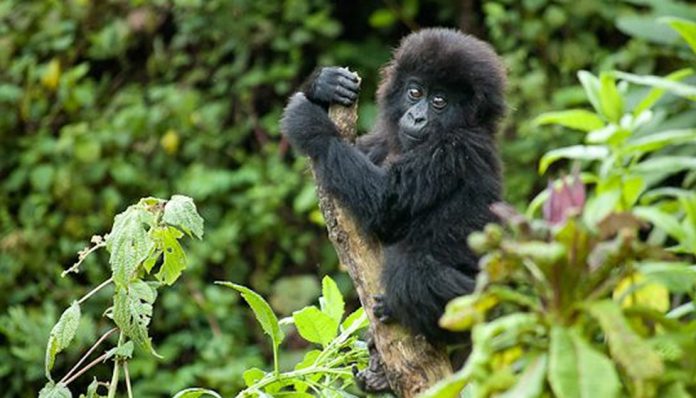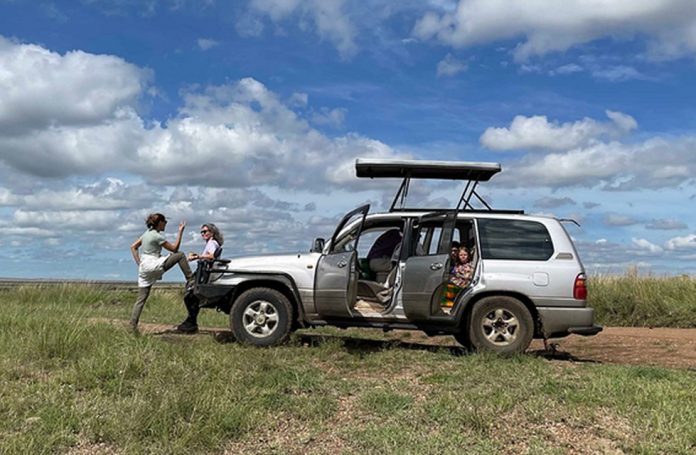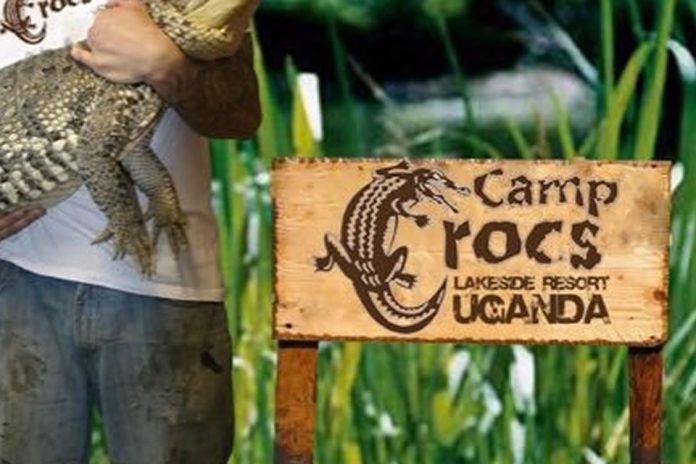Like a typical hot-tempered crocodile, Romeo a giant crocodile probably in his late 40’s can’t stand hearing a single soul provoke his wrath with noise. Aching with burning fury, the hot-tempered beast puffs out air from his lungs in a loud vociferous roar in an attempt to telepathically intimidate all the 11 visitors who have gathered around his roofless artificial pond which is enclosed by a perimeter wall.
To his dismay, not a single lip moved. On the contrary, their cheers continue to pitch higher by the minute as they hung their heads over the enclosure to get better close-ups. Pushed to the limits, he jerks up at once and charges at bullet speeds towards the offenders at the corner where the noise is loudest. Unfortunately, his efforts to rip them apart end in vain. While they feel so near to him because he is right in their face, he feels they are a thousand miles away because between them stands a protective perimeter wall that won’t let him vent his anger.
Frustrated like the devil, he eventually dives back into the shallow pond to cool off his fury. As he floats in the water, his expression is tightly controlled, but all can see the anguish he is feeling by the lines of tension around his green-like eyelids.
This was one of the most memorable moments I along with 10 folks inclusive of the tourism press and tour operators witnessed during a familiarization trip to Camp crocs Lakeside Resort in Masaka – as organized by the Uganda Tourism Board in its commitment to inaugurate understated but outstanding tourism attractions around the country.
Like its name suggests, Camp crocs, located along a pristine stretch of Lake Victoria’s shores in Masaka is the biggest crocodile zoo and most populated croc farm in Uganda famed for breeding over 2000 Nile crocodiles which are grown to various ages mainly for the export of skin to make leather goods such as bags, shoes, belts, briefcases among many.
However, unlike many researchers who have been to the farm on study missions, our visit was typically enveloped on adventure grounds. We wanted to get an up-close with the fierce reptiles in an otherwise safe haven where one is guaranteed of 101% excellent chances of seeing them, unlike in the wild where they are hard to change one due to their unbeaten ability to camouflage in their respective environments.
11:30 am was our time of arrival in the farm’s rugged but delightful endless expanse that was complete with indigenous trees most of which seemed 4 times senior to us in almost all spheres, age, height, resilience among others. Welcoming us into this rustic setting was a flock of cheerful white egrets soaring within reachable heights in an attempt to distract us from recognizing the rather heartbroken sky that was on the verge of tearing down.
However, they weren’t the only ones excited by our arrival, like them, mother nature’s freshness coupled with unpolluted freshness from the immediate twinkly resort that was dotted with all manners of stunning shells was racing to brace us with warmest-feel at home-hugs.
Seated at the heart of this setting were four modest sets of four-roomed colonial-styled roofless buildings sheltered with heat-resistant canvas. Standing beside them were bolded nerve-wracking signposts that warned of any act of trespassing being punishable by eating. As led by Carol Kamugira the Farms welcoming Manager and View Uganda Magazine • 37
Andrew Kazina a reptile expert, the closer our feet inch to them, the more our earbuds are wrecked by beastly roars, the more it feels like we were condemning ourselves to hell. They were crocodile ponds, each accommodating at least 50 crocs of different age brackets from months to ages, each with unique generic personalities and characters that made them stand out from the crowd.
Much as they had beastly characters, like humans, they too had an angelic side especially the young ones who had just been hatched in the preceding weeks. They looked cute, very gentle, and graceful in character. They were floating on their bellies in the blissfully cool and supportive water.
For much of the time, they would roll over and slowly swim a length of the ponds pool, admiring the detailed cracks beneath as rippling water from a running tap fed the pond. From their dreamy expressions, I could guess they were thinking about was their favorite food-silver fish having all that had been served to them earlier on.
In contrast to their character were the 2-year-olds that never tired getting the slightest excuse to exchange fearsome slaps for agonizing kicks and sometimes needle sharp bites.
Surprisingly, with all these bites, there was hardly a scratch on their skins. When the weather became so chilly, they rushed up to the corner and piled up against each other to generate heat while making noticeable hisses to get their points across to each other.
As Henry Lubowa, a caretaker with an over 20 years of experience on the farm served them meaty food, we braced ourselves for what we expected to be the biggest croc fight ever–bearing in mind that crocs are considered the meanest reptiles after dinosaurs.
Shockingly, like a toothless carnivore that had run out of appetite, they all sat back and watched on with the least of interest as though eating the food was a taboo. Not for once did they look back.
According to Lubowa, this reaction was brought about by the chilly temperatures.
“A drop in temperatures directly impacts to a drop in their appetite,” he explained while picking one of the reptiles for us to touch feel.
The safety rules were simple, we were to hold them by the immensely powerful tail and by the tips with as much strong grip as possible, but definitely not too tough to squeeze the life out of the poor thing.
At first grip, many were quick to think of her as a heaven-sent angel though she had a devilish glint in her eyes. However, that was before she changed her character in no time to a threatening brute in an attempt to prove she was equally a heavyweight not to be reckoned with.
Her jaw pressure coupled with sharp teeth made a deadly weapon that left many who dared to hold it struggling with indescribable fear yet all pretended not to know it.
On the other hand, her unyielding skin looked rough but certainly armored like a bulletproof vest that had been soaked in water for quite some time. It was no doubt designed for camouflage.
Like all, I was terrified to risk it but in the end, loved it to bits. Before, it seemed scary and out of ordinary: then the moment after, a super exciting feeling even though it stirred a fright that ravaged me like a blizzard, causing heat from my hand to steadily burn through the sleeve of my linen jacket.
At 3:30, our visit would be crowned with a taste of crocodile meat, something which was a first for many of us. While it looked like goat’s meat, it tasted like a mix of deep-fried fish and grilled chicken.
It was astonishingly good: nowhere else did health taste better or more sophisticated to entice even the most reluctant dieter.
TRAVEL GUIDE
Entrance to the Croc farm is Sh5, 000 exclusives of the croc culinary delight experience.
Though the farm is open to visitors throughout the week, booking one visit ahead is more recommended.
While at the farm, be sure to follow the guide’s advice word by word, otherwise you might risk fatal crocodile strikes.
Other nearby attractions to visit include the equator village, Mpanga eco-tourism site, and manga drum makers.
















